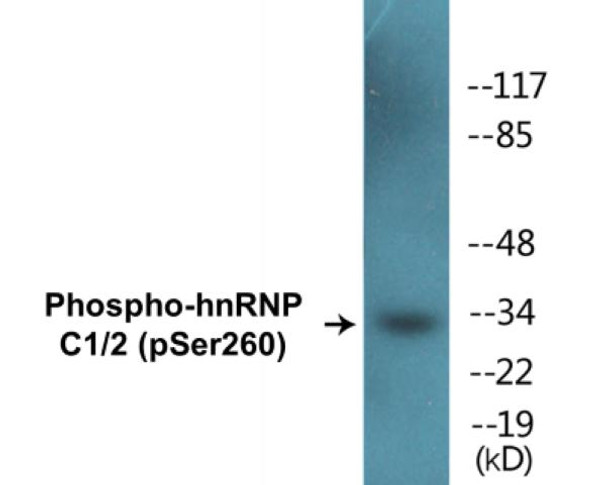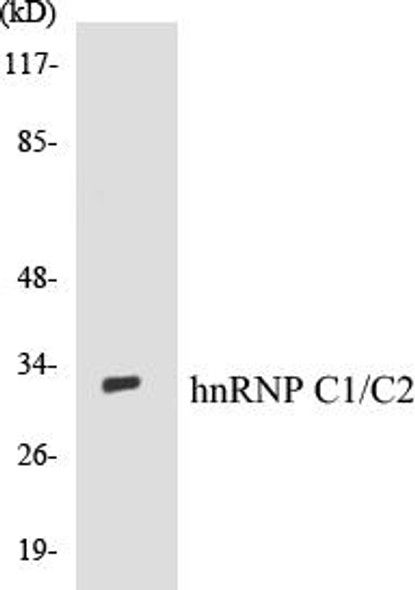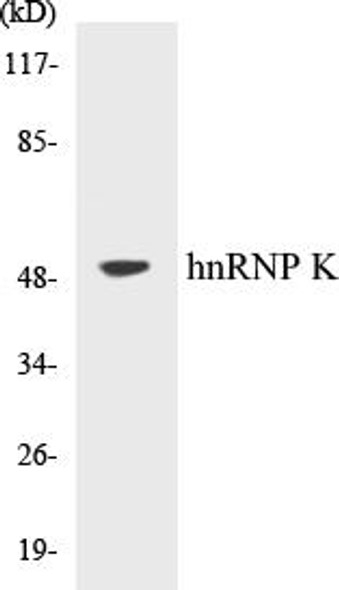Description
| Product Name: | hnRNP C1/2 (Phospho-Ser260) Colorimetric Cell-Based ELISA |
| Product Code: | CBCAB01449 |
| ELISA Type: | Cell-Based |
| Target: | hnRNP C1/2 (Phospho-Ser260) |
| Reactivity: | Human, Mouse, Rat |
| Dynamic Range: | > 5000 Cells |
| Detection Method: | Colorimetric 450 nm |
| Format: | 2 x 96-Well Microplates |
The hnRNP C1/2 (Phospho-Ser260) Colorimetric Cell-Based ELISA Kit is a convenient, lysate-free, high throughput and sensitive assay kit that can detect hnRNP C1/2 protein phosphorylation and expression profile in cells. The kit can be used for measuring the relative amounts of phosphorylated hnRNP C1/2 in cultured cells as well as screening for the effects that various treatments, inhibitors (ie. siRNA or chemicals), or activators have on hnRNP C1/2 phosphorylation.
Qualitative determination of hnRNP C1/2 (Phospho-Ser260) concentration is achieved by an indirect ELISA format. In essence, hnRNP C1/2 (Phospho-Ser260) is captured by hnRNP C1/2 (Phospho-Ser260)-specific primary (1ø) antibodies while the HRP-conjugated secondary (2ø) antibodies bind the Fc region of the 1ø antibody. Through this binding, the HRP enzyme conjugated to the 2ø antibody can catalyze a colorimetric reaction upon substrate addition. Due to the qualitative nature of the Cell-Based ELISA, multiple normalization methods are needed:
| 1. | A monoclonal antibody specific for human GAPDH is included to serve as an internal positive control in normalizing the target absorbance values. |
| 2. | Following the colorimetric measurement of HRP activity via substrate addition, the Crystal Violet whole-cell staining method may be used to determine cell density. After staining, the results can be analysed by normalizing the absorbance values to cell amounts, by which the plating difference can be adjusted. |
| Database Information: | Gene ID: 3183, UniProt ID: P07910, OMIM: 164020, Unigene: Hs.508848/Hs.700762/Hs.708738 |
| Gene Symbol: | HNRNPC |
| Sub Type: | Phospho |
| UniProt Protein Function: | hnRNP C1/C2: a heterogeneous nuclear ribonucleoprotein. May play a role in ribonucleosome assembly by neutralizing basic proteins such as A and B core hnRNP. Contains 1 RNA recognition motif (RRM) domain. Two alternatively spliced isoforms have been described. |
| UniProt Protein Details: | Protein type:Spliceosome; RNA-binding; RNA splicing Chromosomal Location of Human Ortholog: 14q11.2 Cellular Component: cytosol; membrane; nuclear chromatin; nucleoplasm; nucleus; protein complex; spliceosome; telomerase holoenzyme complex Molecular Function:identical protein binding; mRNA 3'-UTR binding; nucleosomal DNA binding; nucleotide binding; poly(U) binding; protein binding; RNA binding Biological Process: ATP-dependent chromatin remodeling; cellular protein metabolic process; gene expression; negative regulation of telomere maintenance via telomerase; nuclear mRNA splicing, via spliceosome; osteoblast differentiation; post-translational protein modification; protein sumoylation; RNA splicing |
| NCBI Summary: | This gene belongs to the subfamily of ubiquitously expressed heterogeneous nuclear ribonucleoproteins (hnRNPs). The hnRNPs are RNA binding proteins and they complex with heterogeneous nuclear RNA (hnRNA). These proteins are associated with pre-mRNAs in the nucleus and appear to influence pre-mRNA processing and other aspects of mRNA metabolism and transport. While all of the hnRNPs are present in the nucleus, some seem to shuttle between the nucleus and the cytoplasm. The hnRNP proteins have distinct nucleic acid binding properties. The protein encoded by this gene can act as a tetramer and is involved in the assembly of 40S hnRNP particles. Multiple transcript variants encoding at least two different isoforms have been described for this gene. [provided by RefSeq, Jul 2008] |
| UniProt Code: | P07910 |
| NCBI GenInfo Identifier: | 108935845 |
| NCBI Gene ID: | 3183 |
| NCBI Accession: | P07910.4 |
| UniProt Secondary Accession: | P07910,P22628, Q53EX2, Q59FD3, Q5FWE8, Q86SF8, Q86U45 Q96HK7, Q96HM4, Q96IY5, D3DS19, D3DS22, |
| UniProt Related Accession: | P07910 |
| Molecular Weight: | 27,822 Da |
| NCBI Full Name: | Heterogeneous nuclear ribonucleoproteins C1/C2 |
| NCBI Synonym Full Names: | heterogeneous nuclear ribonucleoprotein C (C1/C2) |
| NCBI Official Symbol: | HNRNPC |
| NCBI Official Synonym Symbols: | C1; C2; HNRNP; HNRPC; SNRPC |
| NCBI Protein Information: | heterogeneous nuclear ribonucleoproteins C1/C2 |
| UniProt Protein Name: | Heterogeneous nuclear ribonucleoproteins C1/C2 |
| Protein Family: | Heterogeneous nuclear ribonucleoprotein |
| UniProt Gene Name: | HNRNPC |
| UniProt Entry Name: | HNRPC_HUMAN |
| Component | Quantity |
| 96-Well Cell Culture Clear-Bottom Microplate | 2 plates |
| 10X TBS | 24 mL |
| Quenching Buffer | 24 mL |
| Blocking Buffer | 50 mL |
| 15X Wash Buffer | 50 mL |
| Primary Antibody Diluent | 12 mL |
| 100x Anti-Phospho Target Antibody | 60 µL |
| 100x Anti-Target Antibody | 60 µL |
| Anti-GAPDH Antibody | 60 µL |
| HRP-Conjugated Anti-Rabbit IgG Antibody | 12 mL |
| HRP-Conjugated Anti-Mouse IgG Antibody | 12 mL |
| SDS Solution | 12 mL |
| Stop Solution | 24 mL |
| Ready-to-Use Substrate | 12 mL |
| Crystal Violet Solution | 12 mL |
| Adhesive Plate Seals | 2 seals |
The following materials and/or equipment are NOT provided in this kit but are necessary to successfully conduct the experiment:
- Microplate reader able to measure absorbance at 450 nm and/or 595 nm for Crystal Violet Cell Staining (Optional)
- Micropipettes with capability of measuring volumes ranging from 1 µL to 1 ml
- 37% formaldehyde (Sigma Cat# F-8775) or formaldehyde from other sources
- Squirt bottle, manifold dispenser, multichannel pipette reservoir or automated microplate washer
- Graph paper or computer software capable of generating or displaying logarithmic functions
- Absorbent papers or vacuum aspirator
- Test tubes or microfuge tubes capable of storing ≥1 ml
- Poly-L-Lysine (Sigma Cat# P4832 for suspension cells)
- Orbital shaker (optional)
- Deionized or sterile water
*Note: Protocols are specific to each batch/lot. For the correct instructions please follow the protocol included in your kit.
| Step | Procedure |
| 1. | Seed 200 µL of 20,000 adherent cells in culture medium in each well of a 96-well plate. The plates included in the kit are sterile and treated for cell culture. For suspension cells and loosely attached cells, coat the plates with 100 µL of 10 µg/ml Poly-L-Lysine (not included) to each well of a 96-well plate for 30 minutes at 37 °C prior to adding cells. |
| 2. | Incubate the cells for overnight at 37 °C, 5% CO2. |
| 3. | Treat the cells as desired. |
| 4. | Remove the cell culture medium and rinse with 200 µL of 1x TBS, twice. |
| 5. | Fix the cells by incubating with 100 µL of Fixing Solution for 20 minutes at room temperature. The 4% formaldehyde is used for adherent cells and 8% formaldehyde is used for suspension cells and loosely attached cells. |
| 6. | Remove the Fixing Solution and wash the plate 3 times with 200 µL 1x Wash Buffer for five minutes each time with gentle shaking on the orbital shaker. The plate can be stored at 4 °C for a week. |
| 7. | Add 100 µL of Quenching Buffer and incubate for 20 minutes at room temperature. |
| 8. | Wash the plate 3 times with 1x Wash Buffer for 5 minutes each time. |
| 9. | Add 200 µL of Blocking Buffer and incubate for 1 hour at room temperature. |
| 10. | Wash 3 times with 200 µL of 1x Wash Buffer for 5 minutes each time. |
| 11. | Add 50 µL of 1x primary antibodies Anti-hnRNP C1/2 (Phospho-Ser260) Antibody, Anti-hnRNP C1/2 Antibody and/or Anti-GAPDH Antibody) to the corresponding wells, cover with Parafilm and incubate for 16 hours (overnight) at 4 °C. If the target expression is known to be high, incubate for 2 hours at room temperature. |
| 12. | Wash 3 times with 200 µL of 1x Wash Buffer for 5 minutes each time. |
| 13. | Add 50 µL of 1x secondary antibodies (HRP-Conjugated AntiRabbit IgG Antibody or HRP-Conjugated Anti-Mouse IgG Antibody) to corresponding wells and incubate for 1.5 hours at room temperature. |
| 14. | Wash 3 times with 200 µL of 1x Wash Buffer for 5 minutes each time. |
| 15. | Add 50 µL of Ready-to-Use Substrate to each well and incubate for 30 minutes at room temperature in the dark. |
| 16. | Add 50 µL of Stop Solution to each well and read OD at 450 nm immediately using the microplate reader. |
(Additional Crystal Violet staining may be performed if desired – details of this may be found in the kit technical manual.)






